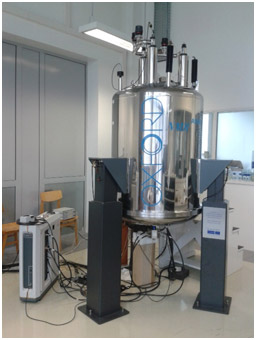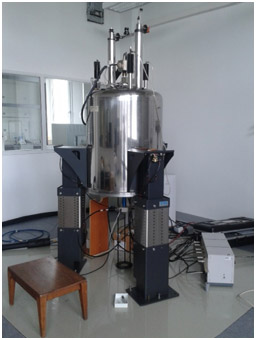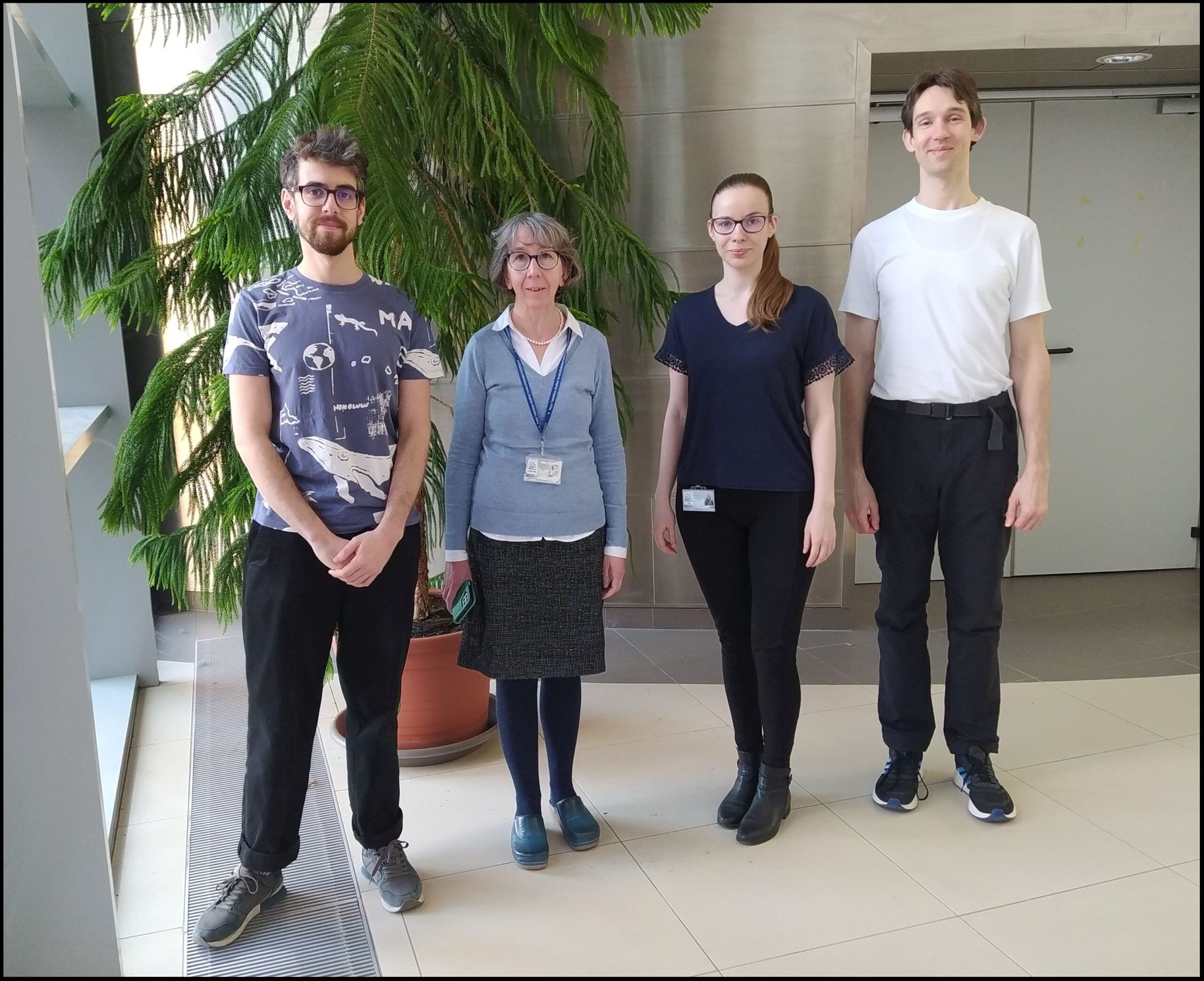In our laboratory we use NMR spectroscopy to study the structural and dynamic aspects of molecular interactions primarily focusing on proteins and polymeric systems. Additionally, in collaboration with other groups, we contribute to research projects in various fields of organic chemistry and material sciences.
I. Structure, dynamics, and function in proteins
NMR spectroscopy has a unique role in structural biology by providing both structural and dynamic information on biomolecules and their interactions. Its further advantage is that the microscopic atomic-level information obtained by NMR can be related to macroscopically measurable thermodynamic and kinetic parameters. Experiments are performed on biosynthetically produced uniformly 15N- (MW<7 kDa) or 13C/15N- (MW=7-25 kDa) enriched proteins.
- identification and mapping of binding sites and interaction surfaces
- structure elucidation
- investigation of internal motions and exchange processes
- residue-level monitoring of unfolding processes
- investigation of membrane peptides in lipid bilyers and membrane mimetics
Ongoing project:
NKFI K 109035: „Investigation of the mechanism of ligand binding in human ileal bile acid-binding protein”, 2014-2018
Related publications:
- O. Tőke (2022) Structural and dynamic determinants of molecular recognition in bile acid-binding proteins. Int. J. Mol. Sci. 23:505. https://doi.org/10.3390/ijms23010505
- Gy. Pálfy, D. K. Menyhárd, H. Ákontz-Kiss, I. Vida, Gy. Batta, O. Tőke, A. Perczel (2022) The importance of Mg2+-free state in nucleotide exchange of oncogenic K-Ras mutants. Chemistry – A European Journal, 28:e202201449. https://doi.org/10.1002/chem.202201449.
- K. Kirsch, A. Zeke, O. Tőke, P. Sok, A. Sethi, A. Sebő, G. S. Kumar, P. Egri, Á. Póti, P. Gooley, W. Peti, I. Bento, A. Alexa, A. Reményi (2020) Nat Commun. 11:5769. https://doi.org/10.1038/s41467-020-19582-3.
- G. Horváth, B. Balterer, A. Micsonai, J. Kardos, O. Tőke (2022) Multiple timescale dynamic analysis of functionally-impairing mutations in human ileal bile acid-binding protein. Int. J. Mol. Sci. 23:11346. https://doi.org/10.3390/ijms231911346.
- O. Tőke, K. Koprivanacz, L. Radnai, B. Merő, T. Juhász, K. Liliom, L. Buday (2021) Solution NMR structure of the SH3 domain of human caskin1 validates the lack of a typical peptide binding groove and supports a role in lipid mediator binding. Cells 10:173. https://doi.org/10.3390/cells10010173.
- G. Horváth, O. Egyed, C. Tang, M. Kovács, A. Micsonai, J. Kardos, O. Tőke (2019) Ligand entry in human ileal bile acid-binding protein is mediated by histidine-protonation. Sci Rep. 9:4825. https://doi.org/10.1038/s41598-019-41180-7.
- B. Merő, L. Radnai, G. Gógl, O. Tőke, I. Leveles, K. Koprivanacz, B. Szeder, M. Dülk, G. Kudlik, V. Vas, A. Cserkaszky, S. Sipeki, L. Nyitray, B. G. Vértessy, L. Buday (2019) Structural insights into the tyrosine phosphorylation-mediated inhibition of SH3 domain-ligand interactions. J. Biol. Chem. 294:4608-4620. https://doi.org/10.1074/jbc.RA118.004732.
- G. Horváth, L. Biczók, Z. Majer, M. Kovács, A. Micsonai, J. Kardos, O. Tőke (2017) Structural insight into a partially unfolded state preceding aggregation in an intracellular lipid-binding protein. FEBS Journal, 284:3637-3661. https://doi.org/10.1111/febs.14264.
- G. Horváth, Á. Bencsura, Á. Simon Á, G. P. Tochtrop, G. T. DeKoster, D. F. Covey, D. P. Cistola, O. Tőke (2016) Structural determinants of ligand binding in the ternary complex of human ileal bile acid-binding protein with glycocholate and glycochenodeoxycholate obtained from solution NMR, FEBS Journal, 283:541-555. https://doi.org/10.1111/febs.13610.
- G. Horváth, O. Egyed, O. Tőke (2014) Temperature dependence of backbone dynamics in human ileal bile acid-binding protein: Implications for the mechanism of ligand binding. Biochemistry, 53:5186-5198. https://doi.org/10.1021/bi500553f.
II. Polymeric systems
NMR spectroscopy is a powerful tool for the study of polymeric systems. The combination of solution- and solid-state NMR techniques are used to elucidate the structure of synthetic/natural polymers and to investigate the various intra- and intermolecular interactions giving rise to their macroscopic characteristics. Systematic studies of host-guest interactions between macromolecules and various biologically active compounds are directed at the development of controlled drug delivery systems.
- investigation of chemical modifications in synthetis/natural polymers
- polymer molecular weight analysis (DOSY NMR)
- structural characterization of polymeric systems in the solid state
- study of intra-/intermolecular interactions of polymers in the solid state
- morphological characterization of polymeric systems with an active substance
Ongoing project:
NKFI K 115939: „Intermolecular interactions in regulated substance delivery systems”, 2015-2019
Related publications:
- E. Kovács, B. Balterer, N. A. Duc, Gy. Szarka, M. C. Owen, A. Domján, B. Iván (2023) Ring-opening metathesis polymerization and related olefin metathesis reactions in benzotrifluoride as an environmentally advantageous medium. Int. J. Mol. Sci. 24:671. doi: https://doi.org/10.3390/ijms24010671
- A. Bulátkó, A. Domján, J. Madarász, K. László (2022) Interactions in dopamine and indole loaded thermosensitive hydrogels seen by high sensitivity microDSC. Implications for drug delivery. J. Therm. Anal. & Calorim. 147:11909-11920. https://doi.org/10.1007/s10973-022-11383-8.
- T. Stumphauser, G. Kasza, A. Domján, A. Wacha, Z. Varga, Y. Thomann, R. Thomann, B. Pásztói, T. M. Trötschler, B. Kerscher, R. Mülhaupt, B. Iván (2020) Nanoconfined crosslinked poly(ionic liquid)s with unprecedented selective swelling properties obtained by alkylation in nanophase-separated poly(1-vinylimidazole)-l-poly(tetrahydrofuran) conetworks. Polymers 12:2292. https://doi.org/10.3390/polym12102292
- A. Kazsoki, P. Szabó, A. Domján, A. Balázs, T. Bozó, M. Kellermayer, A. Farkas, D. Balogh-Weiser, B. Pinke, A. Darcsi, S. Béni, J. Madarász, L. Szente, R. Zelkó (2018) Microstructural distinction of electrospun nanofibrous drug delivery systems formulated with different excipients. Mol Pharm. 15:4214-4225. doi: https://doi.org/10.1021/acs.molpharmaceut.8b00646.
- M. Szabó, B. Berke, K. László, Z. Osváth, A. Domján (2017) Non-covalent interactions between poly(N-isopropylacrylamide) and small aromatic probe molecules studied by NMR spectroscopy. Eur. Polym. J. 93:750-760. https://doi.org/10.1016/j.eurpolymj.2017.03.032
- K. Nikowitz, A. Domján, K. Pintye-Hódi, G. Regdon Jr, (2016) Multivariate calibration of the degree of crystallinity in intact pellets by X-ray powder diffraction. Int. J. Pharmaceutics, 502:107-116. https://doi.org/10.1016/j.ijpharm.2016.02.018
III. Applications in organic chemistry and material sciences
Structure determination of natural and synthetic compounds, conformational analysis, NMR spectroscopic investigation of reaction mechanisms, self-association processes, elucidation of the structural background of unusual mechanistic and optical properties. In addition to the commonly used one- and two-dimensional NMR measurements, diffusion and relaxation NMR experiments are carried out to characterize molecular interactions and dynamic processes, Besides the routinely performed 1H, 13C, 15N, 31P experiments, 19F and exotic nuclei such as 10B/11B, 29Si, 207Pb can also be investigated.
Related publications:
- Zs. Miskolczy, M. Megyesi, G. Turczel, O. Tőke, L. Biczók (2023) Effect of inclusion in sulfobutylether-β-cyclodextrin on the rate of merocyanine-spirobenzopyran reversible photochromic transformations. Dyes and Pigments, 219:111611. https://doi.org/10.1016/j.dyepig.2023.111611.
- B. L. Tóth, G. Sályi, A. Domján, O. Egyed. A. Bényei, Zs. Gonda, Z. Novák (2022) Z-Selective Fluoroalkenylation of (Hetero)Aromatic Systems by Iodonium Reagents in Palladium-Catalyzed Directed C−H Activation. Adv. Synth. & Catal. 364:348-354. https://doi.org/10.1002/adsc.202101108.
- Sz. Varga, P. Angyal, G. Martin, O. Egyed, T. Holczbauer, T. Soós (2020) Total Syntheses of (-)-Minovincine and (-)-Aspidofractinine through a Sequence of Cascade Reactions. Angew. Chem. Int. Ed. 59:13547-13551. https://doi.org/10.1002/anie.202004769.
- D. Fegyverneki, N. Kolozsvári, D. Molnár, O. Egyed, T. Holczbauer, T. Soós (2019) Size-Exclusion Borane Catalyzed Domino 1,3-Allylic/Reductive Ireland-Claisen Rearrangements. Impact of the Electronic and Structural Parameters on the 1,3-Allylic Shift Aptitude. Chemistry – A European Journal 25:2179-2183. https://doi.org/10.1002/chem.201805208
- É. Dorkó, M. Szabó, B. Kótai, I. Pápai, A. Domján, T. Soós (2017) Expanding the Boundaries of Water-Tolerant Frustrated Lewis Pair Hydrogenation: Enhanced Back Strain in the Lewis Acid Enables the Reductive Amination of Carbonyls. Angew. Chem. – Int. Ed. 56:9512-9516. https://doi.org/10.1002/anie.201703591
- P. Baranyai, G. Marsi, Cs. Jobbágy, A. Domján, L. Olah, A. Deák (2015) Mechano-induced reversible colour and luminescence switching of a gold(I)-diphosphine complex. Dalton Trans. 44:13455-13459. https://doi.org/10.1039/c5dt01795e
Cooperations
- RCNS HAS, IOF, Organocatalysis Research Group
- RCNS HAS IE, Protein Interaction Group
- RCNS HAS, IE, Signal Transduction and Functional Genomics Research Group
- RCNS HAS, IE, Cell Architecture Research Group
- RCNS HAS, IMEC, Polymer Physics Research Group
- RCNS HAS, IMEC, Polymer Chemistry Research Group
- RCNS HAS, IMEC, Biological Nanochemistry Research Group
- Biological Research Centre, Szeged and Research Institute of Chemical and Process Engineering, University of Pannonia
- Eötvös University, Department of Organic Chemistry; HAS-ELTE Peptide Research Group
- Eötvös University, Department of Biochemistry, Protein Folding and Amyloid Group
- Eötvös University, Department of Biochemistry, Motor Enzymology Research Group
- Department of Physical Chemistry and Materials Science, Budapest University of Technology and Economics
- Department of Pharmaceutical Technology, University of Szeged
- University of Debrecen, Department of Organic Chemistry
- Karlsruhe Institute of Technology, Germany
- Washington University School of Medicine, St. Louis, USA
Educational activities
- Chemistry & Biology Doctoral School (Ph.D.), ELTE
- Laboratory thesis projects (M.Sc.)
- Summer technical experience courses
Equipments

Varian NMR System(R), 600 MHz, narrow bore spectrometer, 40 channel shims, five RF channels with pulse shaping, DirectDrive(R) technology, 100W and 800W 1H amplifiers, Performa IV. triaxial XYZ pulsed field gradient (PFG) unit, solid-state accessories (CP/MAS), low-gamma option, 1H13C{15N-31P}-XYZ indirect detection triple tunable probe with triaxial gradient, HFC-Z indirect detection triple probe, HCN-Z indirect detection triple probe, 15N-31P{1H-19F} direct detection dual broadband gradient probe, 3.2mm and 6mm HXY Varian/Chemagnetics triple tunable T3 MAS probes, temperature preconditioning unit.

Varian NMR System(R), 400 MHz, narrow bore spectrometer, two RF channels, DirectDrive(R) technology, pulsed field gradient (PFG) unit, AutoX 5mm direct detection dual broadband gradient probe, solid-state accessories (CP/MAS), 4.0mm HX Varian/Chemagnetics T3 MAS probe, temperature preconditioning unit.
Leader
Orsolya Tőke


